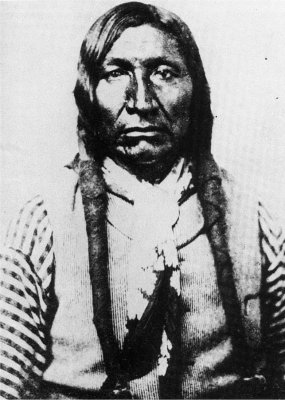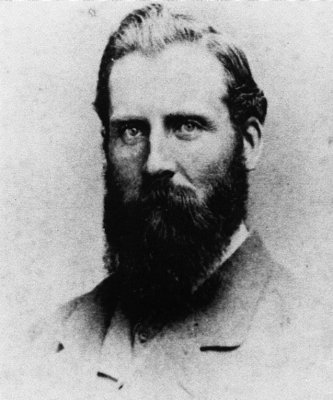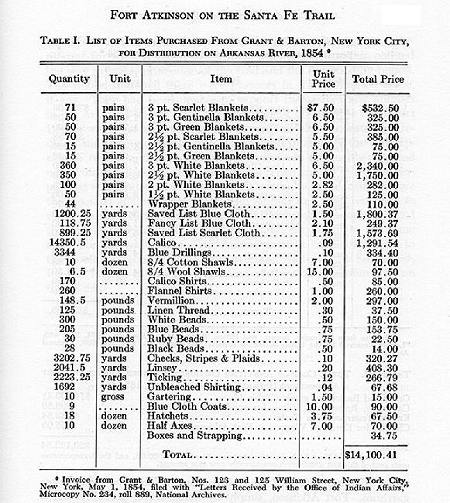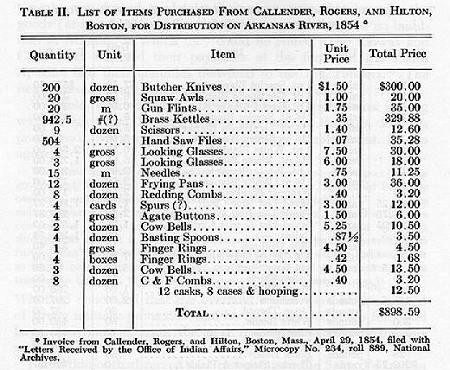|
Lt. Simon Bolivar Buckner, Sixth infantry, assumed command at Fort Atkinson on November 6, 1851. Late that winter, he concluded that it would be in the best interest of the army to withdraw the garrison to Fort Leavenworth during winter months, leaving a small detachment of about a dozen enlisted men and, presumably, the cats, to guard the supplies during that time. This would conserve the scarce firewood, curtail expenditures entailed in supply, and keep troops in better quarters for the season. Buckner's experience showed few travelers during the cold season and no Indian troubles because the natives were in their winter camps. The savings achieved in removing the garrison during the winter could be utilized to provide a sufficient garrison for the remainder of the year, which Buckner declared should consist of at least a company of infantry to construct, guard, and supply the post and two mounted companies to protect travelers and deal with Indians who exhibited hostile threats or actions. [29] Buckner estimated that several thousand Indians would spend the summer in the vicinity of the fort, and he begged for adequate reinforcements to prevent troubles. No troops were sent. By June, 1852, when thousands of Indians were there awaiting Fitzpatrick's arrival with presents, and the post, according to one reporter, was virtually under siege, Buckner demanded reinforcements. [30] Then rumor reached the Missouri settlements that Fort Atkinson had been captured, its garrison massacred, and a large caravan of wagons in the same vicinity destroyed and its people murdered. With a reported 10,000 Indians encamped there, that could have happened but did not. Temporary reinforcements were on the way, for Maj. Winslow F. Sanderson with two companies of Mounted riflemen and one company of First dragoons marched from Fort Leavenworth on July 3 and arrived at Fort Atkinson by July 19. [31] What happened at Fort Atkinson was reported by Charles Hallock (with some embellishment and known inaccuracies) several years later. [32] The Kiowas and Comanches, with some of the Cheyennes and Arapahoes, had gathered to meet with Fitzpatrick and were awaiting his arrival and the distribution of presents. He was delayed because the shipment of presents was late, and as the time passed for the appointed meeting, the Indians became hungry and the grass for their animals was disappearing. They reportedly threatened to attack the soldiers, declaring that they wanted the presents or they would retaliate. At that point the request for reinforcements had been sent. About mid-July, some 300 to 400 Kiowas and Comanches broke into Fort Atkinson after one sentry was knocked down by a warrior. No other violence or damage was reported at the time. Later, when the Indians had returned to their tipis, the troops became brave and a young officer decided to punish the Indian who had struck the sentry. A detachment, with two field pieces, marched from the fort to the Kiowas' encampment and demanded that the guilty Indian be delivered up for punishment. Indian warriors surrounded the detachment, and the troops began to lose their confidence. When the Indian they demanded was handed over to them, they realized that an act against him would likely result in retaliation by the Kiowas. Further trouble was avoided when the lieutenant discreetly turned the guilty Indian back to his chief for punishment. Although surrounded by Indians, the soldiers managed to return to the fort without incident. The Kiowas seemed to divide over the proper reaction, and the forces for peace won over those for war. [33] Into this potential for hostilities, William Bent with a small wagon train (accompanied by Stephen C. King, with an excursion party from Georgia seeking adventure and more healthful conditions for Mrs. King [who incidentally died at Fort Atkinson in late July], and a party of Englishmen led by Charles William Fitzwilliam), in all about 50 persons, arrived at the fort. They had been harassed by the Indians prior to arrival, and their numbers at the post increased its strength. Agent Fitzpatrick still had not arrived, and the situation remained explosive. The Indians could see Bent's wagons, and they demanded distribution of those goods. Bent refused, and his friendship with Arapaho Chief Yellow Bear probably prevented the taking of the train by force. On the other hand, Hallock declared that the Indians did plan a night attack on the train and the fort, but that the war party fled after being alarmed by four deserting soldiers who were breaking away from the garrison. These deserters supposedly spread rumors that the fort had been captured and destroyed. 
Soon after that, the Indians began to break their camps and leave the vicinity. The reason for this became clear at the fort upon the arrival of Major Sanderson with reinforcements. Sanderson commanded Fort Atkinson for 12 days, July 20-July 31. His battalion of riflemen then proceeded to Fort Laramie, accompanied by the King party. Captain Chilton arrived on August 1 and assumed command of the post. His dragoons remained until the grass for the mounts was gone. On September 27 they departed for Fort Leavenworth, leaving one company of infantry under command of Lieutenant Heth at Atkinson. While the mounted troops were present, the infantrymen had been able to lay in some supplies for the coming winter. [34] Fitzpatrick and the presents did not reach Fort Atkinson until the end of August, by which time some 2,000 Indians were again encamped nearby. Distribution of presents followed, and Fitzpatrick laid the groundwork for the negotiation of a treaty with the Kiowas and Comanches the following year. [35] After receiving the presents, the Indians "dispersed on the plains, prosecuting their fall hunts, preparatory to taking up their winter quarters." [36] The little garrison at Fort Atkinson settled down to survive the winter, which was accomplished without incident. With the coming of spring, 1853, the Cheyennes began to raid travelers on the trail, leading Lieutenant Heth to request reinforcements for his garrison and armed escorts for the mail coaches. The escorts were provided and Captain Chilton and his company of First dragoons returned to the post for the third summer in succession, June 24 to August 6. The post did provide some protection to the Santa Fe route during that time. [37] One of the services provided by the garrison was the protection of a mail and stage station for mail contractors between Independence and Santa Fe. Fort Atkinson was used as a relay station soon after it was established in 1850, and the mules were changed and wagons repaired at the point of security. A post office was established at Fort Atkinson on November 11, 1851. [38] This mail station was dependent on the military, and when the fort was abandoned the mail station was removed. The most significant development at Fort Atkinson in 1853 was not the protection of the trail and mail station; the post was the site of treaty negotiations with the Kiowa, Comanche, and Plains Apache bands in the region, fulfilling the plans made by congress, the Indian bureau, and Fitzpatrick in previous years. The agent arrived late in July with presents to distribute upon completion of the treaty arrangements, and he found some 5,000 to 6,000 natives awaiting him. The details of the treaty of Fort Atkinson were worked out in two days. It was signed on July 27, 1853, and provided for peaceful relations, granted the United States the right to use land for roads, depots, and military posts, promised restitution for injuries sustained by either side, provided against Indian attacks in Mexican territory, called for the restoration of captives, and set up annuities of $18,000 (in form of merchandise and provisions) to be paid to the Indians for 10 years, with the possibility of Presidential extension of payments for five additional years. [39] Most likely all the terms were not understood by the Indians, and it was not to be a lasting agreement. A soldier, Sgt. Percival G. Lowe, First dragoons, who was present at the time declared later that it was a "so-called treaty, a renewal of faith, which the Indians did not have in the Government, nor the Government in them." [40] Fitzpatrick reported that the council almost did not get underway because of "the distant and suspicious bearing of the chiefs, and the utter impossibility of obtaining any interpreters who understood their intricate languages." He continued: They were ignorant of the proposals to be made to them, suffering from a scarcity of game, and consequently impatient, watchful, jealous, reserved and haughty. There were no trappers or traders amongst them who could facilitate an interview; no one who could speak a syllable of the English tongue; none present in whom mutual confidence could be reposed; and the "sign language," . . . while it might answer the purpose of barter, could not be relied upon in matters of so much importance and delicacy. Thus, although nothing could exceed the correctness of their behavior at the moment, yet nothing was more uncertain than their intention and action at the end. [41] 
Finally, through the use of Mexican captives and the Spanish language, plus an Arapaho who could communicate with the Comanches, interpretations were repeated until Fitzpatrick believed everything was understood. The fact that negotiations were completed within two days casts doubt on such belief, and the later actions of the Kiowas and Comanches in Texas and Mexico indicated that they either misunderstood or deliberately violated the agreement. Following the signing and the distribution of gifts, the Indians dispersed and moved south. This left the trail open to traffic without harassment from those tribes, but Pawnees attacked a caravan near Ash creek late in August. Fitzpatrick moved on to Fort Laramie to see the northern tribes in his agency. Meanwhile, the distributions of presents brought forth a double protest from Captain Chilton, in command at Fort Atkinson. Chilton and his dragoons had spent three summers at Atkinson, helping to protect travelers on the trail. He first protested against the distribution of presents at points on the trail. The presents, he noted, were usually delayed several months beyond the time expected, and thus the Indians remained in proximity to the road, "impatient, half starving, and not capable of being made to understand the cause of delay." The frequently passing emigrant, merchant, and military supply trains were thus inducements to hostilities, and the Indians begged, stole, and in other ways created problems which the military was expected to prevent but did not possess the means to do so. Second, Chilton was angry because guns and ammunition were among the presents to the natives. He declared that the Indians used only bows and arrows for hunting, and the guns, powder, and bullets were used solely to make war. The combination of these two Indian bureau practices was making his job an impossible task. [42] Chilton had found guns and ammunition among the presents Fitzpatrick had brought out in 1852, had protested against their distribution, and placed them in the Fort Atkinson magazine where they remained. He had assumed no more weapons would be given, but had discovered 50 guns, 475 pounds of powder, and 30 sacks of bullets among the presents given after the treaty was signed. This prompted his protest. His successor, Cpt. Edward Johnson, filed a similar remonstrance against the Indian bureau. [43] It is possible that these Indians could obtain guns and ammunition from the traders, too, but they must not have been well armed in the early 1850's. Agent John Whitfield reported in 1854 that the tribes along the Arkansas river were without guns. Whether the protests of the officers at Fort Atkinson were the reason or not, there were no weapons included in the first annuity distribution under the treaty of Fort Atkinson the following year. [44] Fitzpatrick elaborated on the treaty negotiations in his annual report, and what he had to say about military posts is of interest to this evaluation of Fort Atkinson. The Indians were, of course, opposed to this concession and agreed only with reluctance. There is decided aversion among all . . . the Indians to the establishment of military settlements in their midst. They consider that they destroy timber, drive off the game, interrupt their ranges, excite hostile feelings, and but too frequently afford a rendezvous for worthless and trifling characters. Their efficacy, too, for insuring the security of the country, is perhaps overrated, as at present existing, although under the command of excellent and efficient officers, who are always zealous in the performance of their duties; yet so small is the force usually at their disposal, that they maintain their own position in the country more by the courtesy of the Indians than from any ability to cope with the numbers that surround them. Instead of serving to intimidate the red man, they rather create a belief in the feebleness of the white man. In fact, it must be at once apparent that a skeleton company of infantry or dragoons can add but little to the security of five hundred miles square of territory; nor can the great highways . . . be properly protected by a wandering squadron that parades them once a year. Indeed, the experience of the last few years would show, that white emigrant,; who relied on such defences have often lost their lives, those who were more vigilant, and trusted to their own arms for safety, have only lost their animals. [45] Despite all this, Fitzpatrick had followed his instructions to insist on the right, and it was accordingly incorporated. Yet, having done so, I feel it incumbent . . . to urge upon the government the propriety either of increasing the forces at such places, or else of abolishing such posts altogether. Our relations with the wild tribes of the prairie and mountains resolve themselves into a simple alternative. The policy must be either an army or an annuity. Either an inducement must be offered to them greater than the gains of plunder, or a force must be at hand able to restrain and check their depredations. Any compromise between the two systems will be only productive of mischief, and liable to all the miseries of failure. It will beget confidence, without providing safety; it will neither create fear, nor satisfy avarice; and, adding nothing to the protection of trade and emigration, will add everything to the responsibilities of the governments. [46] Fitzpatrick's analysis was to prove prophetic. Even so, by the time this was written, Fort Atkinson had been abandoned (although it would be reoccupied temporarily the following spring and summer). The location, as noted, had not proved satisfactory. On May 12, 1853, departmental headquarters directed the removal of the fort to Walnut creek, and the post commander, Captain Johnson, began preparations. [47] On June 24 Captain Chilton and his company of dragoons arrived for the summer, and Chilton assumed command of the fort the following day. Captain Johnson was later sent with a company of infantry to locate a camp site on Walnut creek, and the troops began moving military provisions to the new camp. On June 28 a directive was sent from department headquarters ordering the development of a post at Walnut creek to be suspended, apparently because efforts were to be concentrated on the new Fort Riley which had been garrisoned in May. Thus Captain Johnson returned to Fort Atkinson on August 4 and assumed command on August 6 when Chilton left to patrol the trail to New Mexico. Another departmental order arrived at Atkinson on August 14, directing that the post be abandoned and the troops and public property be removed to Fort Riley. On August 22 the post office at Atkinson was discontinued, and it was moved to Walnut creek. Contractors were engaged to transport the public property to Riley, and the troops departed Fort Atkinson on September 22. Before leaving they knocked down the sod structures so Indians could not hide in them and surprise travelers on the road. [48] |





